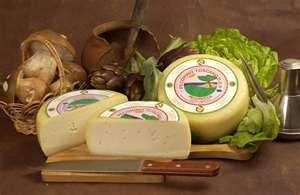Murcia al Vino is produced in the hot and dry Murcia region in southeastern Spain. This goat cheese was granted Denominations of Origin Certification in July of 2001. The Murciano-Granadina goat is indigenous here and is perfectly suited to the demanding Mediterranean environment and is considered to be Spain's best milk producing breed. The sheppards allow their herds to migrate and graze on grass, shrubs and wild herbs as the seasons progress, and in turn the goats produce a sweet, protein rich milk that is used to make cheese.
Spanish Cheese Sampler at Amazon
Details: Murcia al Vino is a pasteurized but not cooked, pressed, semi-soft cheese. After the cheese has been pressed and allowed to dry it is immersed in local Murcian wine and aged for about 75 days. Since it is immersed in wine it has come to be known as the "Drunken Goat" cheese, so if you hear this name you will know that it is Murcia al Vino. This is technically a washed rind cheese but it does not have an overpowering aroma and has a very low stink rating. The wine bath imparts its flavor and burgundy color to the outer rind thus producing a distinctive and colorful cheese with a fruity scent of wine. The rind of this cheese is edible and once cut will reveal a bone white interior paste.
Tasting: The flavor of Murcia al Vino has a hint of salt a slight acidic tang and a hint of wine but not an overt goaty taste. Overall this is a mild cheese that is not really complex but it will reward your palate. Murcia al Vino has a low fat content of 45%.
Spanish Cheese Sampler at Amazon
Details: Murcia al Vino is a pasteurized but not cooked, pressed, semi-soft cheese. After the cheese has been pressed and allowed to dry it is immersed in local Murcian wine and aged for about 75 days. Since it is immersed in wine it has come to be known as the "Drunken Goat" cheese, so if you hear this name you will know that it is Murcia al Vino. This is technically a washed rind cheese but it does not have an overpowering aroma and has a very low stink rating. The wine bath imparts its flavor and burgundy color to the outer rind thus producing a distinctive and colorful cheese with a fruity scent of wine. The rind of this cheese is edible and once cut will reveal a bone white interior paste.
Tasting: The flavor of Murcia al Vino has a hint of salt a slight acidic tang and a hint of wine but not an overt goaty taste. Overall this is a mild cheese that is not really complex but it will reward your palate. Murcia al Vino has a low fat content of 45%.
When shopping for a fresh cut of Murcia al Vino look for a burgundy colored rind that is not cracked or shows other signs of age. There should not be any mold on the outer rind or on the interior paste. If the interior paste looks dry or that it is turning yellow avoid it as this will indicate that it is past its prime. A convenient way to purchase this cheese is in pre-wrapped 12oz mini-wheels. Normally we like to advocate fresh cut cheeses but this convenient size and package provides an ample portion of cheese. Also a wedge cut mini-wheel makes a colorful addition to a cheese board or cheese plate.
Serving Murcia al Vino can be sliced onto your favorite sandwich or shaved into salads to add an interesting new flavor and a distinctive color.
Wine pairing: Spanish reds like Rioja or Riberia del Duero or other fruity Spanish reds and whites.



















